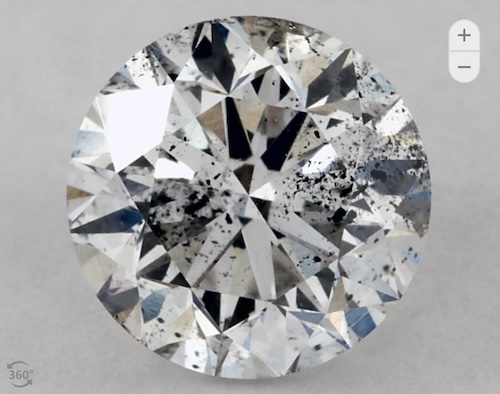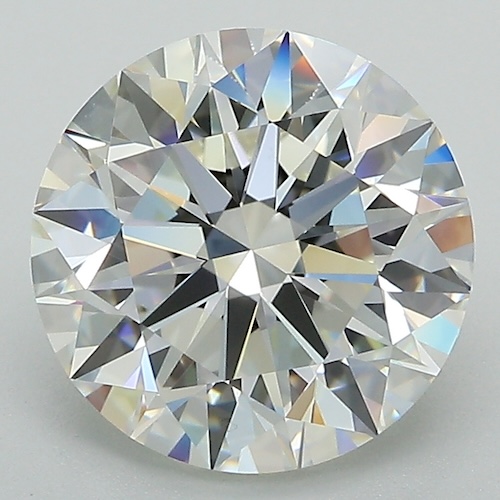©2024 Lab Diamonds Reviews – All Right Reserved.
Education
Lab Grown Diamond Clarity

This article has mentions of products from one or more companies, and I may receive compensation if you purchase those products following reading my recommendations.
Diamond clarity refers to the absence of inclusions and blemishes in a diamond. Inclusions are internal characteristics, while blemishes are surface imperfections. The clarity of a diamond is assessed using a standardized clarity chart developed by the Gemological Institute of America (GIA), which grades diamonds on a scale from Flawless (FL) to Included (I). This scale includes:
What's In This Guide
ToggleThe Diamond Clarity Chart
- Flawless (FL): No inclusions or blemishes visible under 10x magnification.
- Internally Flawless (IF): No inclusions and only minor blemishes visible under 10x magnification.
- Very, Very Slightly Included (VVS1 and VVS2): Inclusions so slight they are difficult for a skilled grader to see under 10x magnification.
- Very Slightly Included (VS1 and VS2): Inclusions are observed with effort under 10x magnification but can be characterized as minor.
- Slightly Included (SI1 and SI2): Inclusions are noticeable under 10x magnification.
- Included (I1, I2, and I3): Inclusions are obvious under 10x magnification and may affect transparency and brilliance.

The clarity grade plays a crucial role in determining a diamond’s value, with higher clarity diamonds being rarer and more valuable. However, many inclusions and blemishes are too tiny to be seen by the naked eye, allowing for a range of clarity choices depending on personal preference and budget.
For top-tier lab-grown diamonds, my premier recommendation is Whiteflash, followed closely by Brilliant Earth and James Allen. Explore these options for unparalleled quality and craftsmanship.
What is the Best Diamond Clarity?
The pinnacle of diamond clarity is undoubtedly the Flawless (FL) grade, indicating a diamond without any inclusions or blemishes when examined under 10x magnification. However, despite its prestige, a Flawless diamond is not always the recommended choice for many customers due to its rarity and high price point.
For most buyers, the clarity range from Very, Very Slightly Included (VVS1) to Very Slightly Included (VS2) offers a practical and visually appealing compromise. Diamonds within this clarity range often provide an excellent balance between beauty and value. The key is to look for “eye-clean” diamonds—stones that show no visible inclusions or blemishes to the naked eye. It’s important to note that vendors may have slightly different standards for what constitutes “eye-clean,” so it’s advisable to consult with a diamond expert or ask for detailed images if shopping online.
This level of personalized service and the ability to inspect diamonds closely is typically available from vendors who maintain their own inventory, such as Whiteflash. They can provide detailed insights and imagery for each diamond, ensuring that you make an informed decision based on both the official clarity grade and the real-world appearance of the stone.
Are I2 and I3 Diamonds Worth It?
When considering the purchase of a diamond, the clarity grade is a crucial factor. I2 and I3 diamonds sit at the lower end of the clarity scale, characterized by obvious inclusions that are visible to the naked eye and can significantly affect the stone’s brilliance and overall appearance. The question arises: Are these diamonds worth the investment?

If you find this I1 diamond less than appealing, just imagine the visible imperfections in I2 and I3 grades.
The straightforward answer is no. While natural diamonds with I2 and I3 clarity grades might be tempting due to their lower price points, the visible inclusions compromise the beauty and desirability of the diamond. These grades indicate that the diamond has significant flaws that can detract from its sparkle and may even affect its structural integrity.
For those considering a diamond purchase, it’s advisable to explore higher clarity grades or consider the value offered by lab-grown diamonds. Lab-grown diamonds typically do not come in these lower clarity grades, as the controlled conditions of their creation often result in higher quality outcomes. Opting for a higher clarity, larger lab-grown diamond could provide better value for your budget, offering the beauty and brilliance you seek at a more attractive price point.
What is a Clarity Enhanced Diamond?
Clarity enhanced diamonds are natural diamonds that have undergone treatment to improve their apparent clarity. This enhancement process typically involves filling fractures or laser drilling to remove inclusions, making imperfections less visible to the naked eye. While these treatments can significantly enhance a diamond’s appearance, making lower clarity diamonds look more appealing, they come with certain drawbacks.

While clarity enhancement can dramatically change a diamond’s appearance, it’s important to note that reputable vendors generally do not deal with clarity-enhanced diamonds due to concerns over authenticity and value.
The primary methods of clarity enhancement include:
- Fracture Filling: This involves injecting a glass-like substance into surface-reaching cracks, which reduces their visibility.
- Laser Drilling: This technique uses lasers to create microscopic channels to reach and bleach dark inclusions, making them less noticeable.
It’s important to note that clarity enhanced diamonds should generally be avoided for several reasons:
- Durability: The treatments can affect the diamond’s structural integrity, making it more susceptible to damage.
- Value: Enhanced diamonds are less valuable than their non-enhanced counterparts and may depreciate more over time.
- Transparency: Disclosure of enhancements is mandatory, but the details might not always be clear, leading to potential misunderstandings about the diamond’s natural quality.
Given these considerations, shoppers looking for quality and value are advised to opt for non-enhanced diamonds. For those on a budget, considering a higher clarity lab-grown diamond might offer better value and peace of mind compared to a clarity enhanced natural diamond.
Final Thoughts & Recommendations
Understanding diamond clarity and its impact on a diamond’s appearance and value is crucial for making an informed purchase. While Flawless diamonds represent the pinnacle of clarity, opting for diamonds in the VVS1 to VS2 range can offer a balance of quality and value, with many being “eye clean” to the naked eye. It’s advisable to steer clear of I2 and I3 clarity natural diamonds due to their noticeable imperfections. Similarly, clarity enhanced diamonds, despite their initial appeal, present issues regarding durability, value, and transparency, making them less desirable. Prioritizing non-enhanced, higher clarity diamonds, or considering lab-grown options, can ensure a more satisfactory investment in both beauty and longevity. For guidance on selecting a reputable vendor that aligns with these quality standards, consider reading my reviews on Whiteflash, Brilliant Earth, and James Allen.

